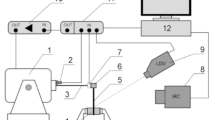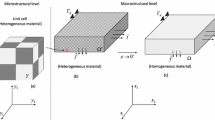The model of multiphase media analyzes the effectiveness of describing thermal expansion and shrinkage of unidirectional polymer composites at their uniform heating by linear law. It is shown that the nature of change in thermal deformation as a function of the composite temperature is similar for an unreinforced matrix, and the maximum absolute value of chemical shrinkage is slightly lower than that of a matrix. The calculated deformations describing thermal expansion are compared with experimental deformations obtained in the process of thermal-oxidative destruction.





Similar content being viewed by others
References
M. A. Grinfeld, Methods of Solid Media Mechanics in the Theory of Phase Transformations [in Russian], Nauka, Moscow (1990).
R. I. Nigmatulin, Fundamentals of Mechanics of Heterogeneous Media [in Russian], Nauka, Moscow (1978).
Yu. I. Dimitrienko, Thermomechanics of Composite Structures under High Temperatures, Springer (2015).
Composite Materials Handbook. Vol. 2: Polymer Matrix Composite Materials Properties, MIL-HDBK-17-2F (1999).
Å. M. Tolstopyatov, “Laser ablation of polymers (review),” Polimer. Mater. Tekhnol., 2, No. 1, 6–20 (2016).
N. K. Kucher and A. A. Samusenko, “Assessment of elasticity characteristics and strength parameters of unidirectional polymer composites at high temperatures,” Strength Mater., 49, No. 3, 453–463 (2017).
N. K. Kucher and A. A. Samusenko, “Mathematical prediction of strength of ablating polymer unidirectional composites in transverse direction and in shear along and across fibers,” Strength Mater., 50, No. 4, 575–583 (2018).
R. M. Christensen, Mechanics of Composite Materials, Wiley-Interscience, New York (1979).
N. Winya, S. Chanrapoe, and C. Kiriratnikom, “Ablation, mechanical and thermal properties of fiber/phenolic matrix composites,” Int. J. Mater. Metall. Eng., 6, No. 9, 875–878 (2012).
N. Winya, A. Boonpan, and K. Prapunkarn, “Study of factors affecting the ablation rate of phenolic resin/fiber class,” Int. J. Chem. Eng. Appl., 4, No. 4, 234–237 (2013).
P. Ngamsantivongsa, S. Boonthalarath, B. Wong-ek, et al. “Development and characterization of ablative materials used for rocked motors,” in: Third Asian Conf. Defense Technology (January 18–20, 2017, Phuket, Thailand) (2017), pp. 110–114, https://doi.org/https://doi.org/10.1109/ACDT.2017.7886168.
Author information
Authors and Affiliations
Corresponding author
Additional information
Translated from Problemy Prochnosti, No. 5, pp. 115 – 122, September – October, 2020.
Rights and permissions
About this article
Cite this article
Kucher, M.K., Yakovleva, O.S. & Chyzhyk, O.O. Thermal Expansion and Shrinkage of Unidirectional Composites at Elevated Temperatures. Strength Mater 52, 790–797 (2020). https://doi.org/10.1007/s11223-020-00232-4
Received:
Published:
Issue Date:
DOI: https://doi.org/10.1007/s11223-020-00232-4




